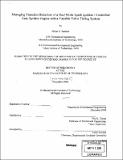Managing transient behaviors of a dual mode spark ignition-- controlled auto ignition engine with a variable valve timing system
Author(s)
Santoso, Halim G. (Halim Gustiono), 1975-
DownloadFull printable version (12.53Mb)
Other Contributors
Massachusetts Institute of Technology. Dept. of Mechanical Engineering.
Advisor
Wai K. Cheng.
Terms of use
Metadata
Show full item recordAbstract
Gasoline Homogeneous Charge Compression Ignition (HCCI) engine has the potential of providing better fuel economy and emissions characteristics than current spark ignition engines. One implementation of this technology employs a Variable Valve Timing (VVT) system and is also often referred to as Controlled Auto Ignition (CAI) combustion in the literature. The objective of the study can be divided into two topics. First, the dynamic nature of load trajectory and several important phenomena in CAI mode were investigated. Second, the issues encountered during mode transition between SI and CAI regime were considered. Despite wide-open-throttle operation, pumping loss in CAI mode was not negligible. A major source of pumping loss in CAI mode was the heat transfer to cylinder wall during the recompression process due to the high in-cylinder residual gas temperature. The influence of fuel air equivalence ratio on combustion stability was analyzed to explain the misfires phenomenon in fuel rich condition during transient operation. Heat release analysis has been conducted to characterize the combustion process in CAI mode. Large variations of the 50% burned point due to fluctuation of residual gas mass and temperature were observed. Small step changes in valve timings (EVC, EVO, and IVC) and fueling resulted in a new steady state within 3-4 engine cycles at 1500 rpm. These small step changes are reversible in nature. Sudden large step change in load required much longer time to reach steady state due to the time required for thermal stabilization. Misfires were observed in large low-load-to-high-load step change but not in high-load-to-low-load step change. (cont.) A simple open loop controller based on linear interpolation of fuel injection and valve timing events was implemented to assess the time scale required to avoid misfires during large load perturbation. Mode transition from the SI to CAI regime may be categorized as failed, non-robust, and robust. In a failed transition, the engine would not reach steady state CAI combustion. In a non-robust transition, one or more intended CAI cycles misfire, although the cycles progress to a satisfactory CAI operating after a few cycles. In robust transition, every intended CAI cycle is successful. A mode transition strategy based on late IVC and fuel metering strategy has been proposed. Smooth and robust modes transitions both from SI to CAI and vice versa have been experimentally demonstrated by implementing this strategy.
Description
Thesis (Ph. D.)--Massachusetts Institute of Technology, Dept. of Mechanical Engineering, February 2005. "December 2004." Includes bibliographical references (p. 127-130).
Date issued
2005Department
Massachusetts Institute of Technology. Department of Mechanical EngineeringPublisher
Massachusetts Institute of Technology
Keywords
Mechanical Engineering.